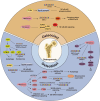Aberrant Tryptophan Metabolism Manipulates Osteochondral Homeostasis
- PMID: 40496774
- PMCID: PMC12150400
- DOI: 10.34133/research.0728
Aberrant Tryptophan Metabolism Manipulates Osteochondral Homeostasis
Abstract
Tryptophan (Trp), an essential amino acid, performs as a precursor for synthesizing various bioactive molecules primarily metabolized through the kynurenine (Kyn), serotonin, and indole pathways. The diverse metabolites were deeply implicated in multiple physiological processes. Emerging research has revealed the multifaceted contribution of Trp in skeletal health and pathophysiology of bone-related disease with the involvement of specific receptors including aryl hydrocarbon receptor (AhR), which modulated the downstream signaling pathways to manage the expression of pivotal genes and thereby altered cellular biological processes, such as proliferation and differentiation. Accompanied by distinct alterations in immune function, inflammatory responses, endocrine balance, and other physiological aspects, their impact and efficacy in osteochondrogenic disorders have also been well documented. Nevertheless, a thorough understanding of Trp metabolism within bone biology is currently lacking. In this review, we elucidate the complexities of Trp metabolic pathway and several metabolites, delineating their versatile modulatory roles in the physiology and pathology of osteoblasts (OBs), osteoclasts (OCs), chondrocytes, and intercellular coupling effects, as well as in the progression of osteochondral disorder. Moreover, we comprehensively delineate the regulatory mechanisms by which gut microbiota-generated indole derivatives mediate bidirectional crosstalk along the gut-bone axis. The establishment of an elaborate governing network about bone homeostasis provides a novel insight on therapeutic interventions.
Copyright © 2025 Tingwen Xiang et al.
Conflict of interest statement
Competing interests: The authors declare that they have no competing interests.
Figures






Similar articles
-
Impact of the Gut Microbiota on Intestinal Immunity Mediated by Tryptophan Metabolism.Front Cell Infect Microbiol. 2018 Feb 6;8:13. doi: 10.3389/fcimb.2018.00013. eCollection 2018. Front Cell Infect Microbiol. 2018. PMID: 29468141 Free PMC article. Review.
-
Involvement of the microbiota-gut-brain axis in chronic restraint stress: disturbances of the kynurenine metabolic pathway in both the gut and brain.Gut Microbes. 2021 Jan-Dec;13(1):1-16. doi: 10.1080/19490976.2020.1869501. Gut Microbes. 2021. PMID: 33535879 Free PMC article.
-
Microbiota, Tryptophan and Aryl Hydrocarbon Receptors as the Target Triad in Parkinson's Disease-A Narrative Review.Int J Mol Sci. 2024 Mar 2;25(5):2915. doi: 10.3390/ijms25052915. Int J Mol Sci. 2024. PMID: 38474162 Free PMC article. Review.
-
Activation of aryl hydrocarbon receptor (AhR) in Alzheimer's disease: role of tryptophan metabolites generated by gut host-microbiota.J Mol Med (Berl). 2023 Mar;101(3):201-222. doi: 10.1007/s00109-023-02289-5. Epub 2023 Feb 9. J Mol Med (Berl). 2023. PMID: 36757399 Free PMC article. Review.
-
Amino Acid Trp: The Far Out Impacts of Host and Commensal Tryptophan Metabolism.Front Immunol. 2021 Jun 4;12:653208. doi: 10.3389/fimmu.2021.653208. eCollection 2021. Front Immunol. 2021. PMID: 34149693 Free PMC article. Review.
References
-
- Wu G. Amino acids: Metabolism, functions, and nutrition. Amino Acids. 2009;37(1):1–17. - PubMed
-
- Vécsei L, Szalárdy L, Fülöp F, Toldi J. Kynurenines in the CNS: Recent advances and new questions. Nat Rev Drug Discov. 2013;12(1):64–82. - PubMed
-
- Agus A, Planchais J, Sokol H. Gut microbiota regulation of tryptophan metabolism in health and disease. Cell Host Microbe. 2018;23(6):716–724. - PubMed
Publication types
LinkOut - more resources
Full Text Sources

